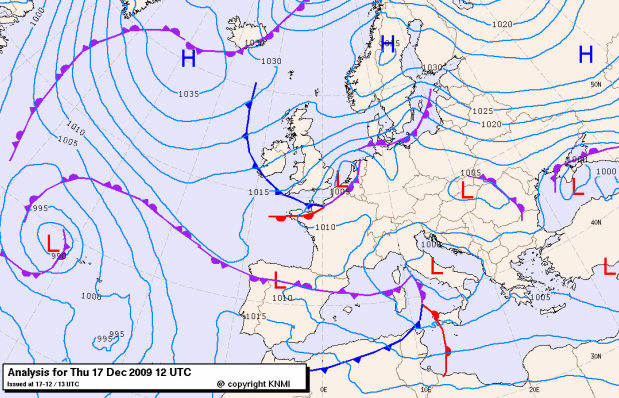Introduction
The winter of 2009/2010 will be by most people remembered as being long, cold and very intensive as precipitation concerns. If we concentrate on the Netherlands however, the figures show otherwise.
With an average temperature of 1.1 °C the winter was only 2 °C colder than the long-term average of 3.3 °C. The precipitation was around 210 mm to a long-term avarage of 194 mm. Exceptionally however for this winter was the number of days with snowcover (42 days versus 13 day long-term avarage). Its especially this snow and the effect this has on our own personal life that helps us to memorise the winter of 2009/2010 as exceptional.
One of these snow events happened during the second half of December 2009. A Cold Air Outbreak directed by a strong anticyclone near Greenland directed polar air towards Europe. With the still relative warm waters of the North Sea and the genesis of several small scale disturbances over Skandinavia and Germany the ingredients were in place for many centimeters of snow in the UK, Netherlands and Germany.
The largest impacts the snow brought were experienced from 16 to 20 December. The largest railway station in the Netherlands (Utrecht CS) was closed on 17 december due to snowfall leaving thousands of passengers stranded. During the morning rush hour of 18 December there was a record breaking 671 kilometers of traffic jam. In England the snowfall had also lead to chaos when motorists were stuck on the A21 during the evening and night of 17 to 18 December. The next night five international EUROSTAR trains were stuck in the tunnel under the English Channel leaving 2.000 passengers trapped for 16 hours.
From a meteorological point of view the this cold air outbreak is interesting as many parts of Europe were affected and that there were different conceptual models responsible which can be distinguished using satellite and numerical weather data. All of these will be described in detail in this case study.
Further South-East also the winter came in the same period with also an abundance of snowfall affecting public life in Croatia, Slovenia Kosovo, and Austria.
At the same time as in the north-west, the winter conditions stroke also the south-eastern part of the continent. Heavy snowfall and extreme coldness affected public life in most countries of central and south-eastern Europe. In Zagreb, the capital city of Croatia, almost 50 people were injured when a train hit a buffer after failing to stop in the main railway station, presumably due to frozen railways. In Pristina, capital of Kosovo one person has died and ten people have been injured in traffic accidents due to poor weather conditions. Dozens of people in Europe froze to death and even more were injured in numerous traffic accidents.
Extreme weather conditions occurred under the influence of a persistent cyclonic activity in the Mediterranean Sea, with cyclones moving from west to east. The centre of a Genoa low was moving towards the eastern Mediterranean on 19th and 20th December, resulting in huge amount of snow, especially in the western part of Croatia and in the Istria peninsula.
In the movie on the link, a time-lapse of snowfall in Zagreb can be seen.
From a meteorological point of view this cold air outbreak is interesting as many parts of Europe were affected and there were different conceptual models responsible which can be distinguished using satellite and numerical weather data. All of these will be described in detail in this case study.
Figure 1.1: Surface chart 17 December 2009 12UTC. Belt of high pressure over Northern Europe dictating the weather - source KNMI
In this case study we will first start to describe (Chapter 2) the genesis of this cold air outbreak by looking at climatological data and compare these with the surface fields. Chapter 3 will then continue to go in depth on the (synoptic) cause of the cold air outbreak and the massive snowfall in the Netherlands from 16 to 20 December. Chapter 4 will deal with the snowfall in Engeland which occured at the same time but was caused by a different conceptual model. In Chapter 5 the snowfall in Croatia will be discussed. The conclusions and a summary of the differences that lead to this snowfall in these two regions of Europe are further described in Chapter 6.
If you think you can contribute to this Case Study or you have suggestions or questions please feel free to contact us.
